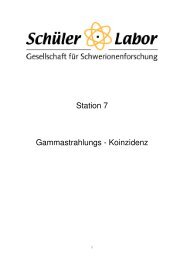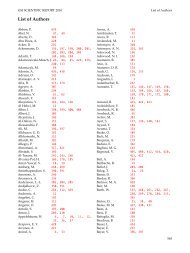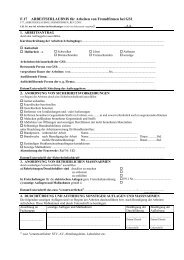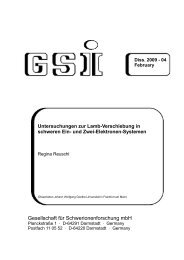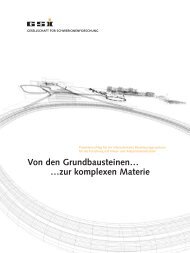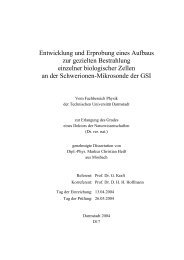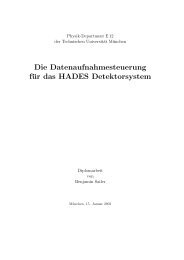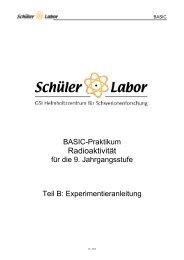CBM Progress Report 2006 - GSI
CBM Progress Report 2006 - GSI
CBM Progress Report 2006 - GSI
Create successful ePaper yourself
Turn your PDF publications into a flip-book with our unique Google optimized e-Paper software.
FEE and DAQ <strong>CBM</strong> <strong>Progress</strong> <strong>Report</strong> <strong>2006</strong><br />
Development of a test system for n-XYTER ASICs<br />
A. Czermak 1 , P. Ku´smierski 2<br />
1 Institute of Nuclear Physics (IFJ), PAN, Krakow, Poland; 2 Jagiellonian University, Krakow, Poland<br />
We report on the progress at IFJ PAN with a readout system<br />
for comprehensive tests of the n-XYTER ASIC. The<br />
chip, developed by the DETNI Consortium and discussed<br />
in [1], will be used for prototype detector developments in<br />
the <strong>CBM</strong> experiment.<br />
The SUCIMA DAQ board test system<br />
The test system, which is based on the existing SUCIMA<br />
Imager Module [2], has been adapted to operate the chip<br />
and allows to perform a variety of laboratory measurements<br />
with the ASIC, eventually being connected to silicon detectors.<br />
A dedicated n-XYTER interface board has been<br />
designed that matches geometrically and electrically the<br />
SUCIMA data acquisition module. The SUCIMA board<br />
is shown in Fig. 1 mounted on top of an ASIC interface<br />
board carrying the 32-channel version of the 128-channel<br />
n-XYTER chip, called MSGCROC.<br />
Figure 1: SUCIMA DAQ module on MSGCROC board.<br />
First results from the MSGCROC chip<br />
We have developed the VHDL programs for the basic<br />
FPGA logic on the DAQ board as well as the software<br />
for the Graphical User Interface. In collaboration with<br />
DETNI, the software has already been used for initial tests<br />
of the MSGCROC chip, including data storage, performance<br />
analysis and documentation of the test results. All<br />
measurements have been performed at nominal 3.3 V supply<br />
and nominal bias currents controlled by internal digitalto-analog<br />
converters. The internal bias reference currents,<br />
discrimination threshold voltage and various test modes in<br />
the ASIC are set via the SUCIMA board and the I 2 C interface.<br />
Test results for trigger efficiency versus thresholds<br />
for different input charges are presented in Fig. 2, and pulse<br />
waveforms recorded at the output of the slow shaper (with<br />
gain set to 1) in Fig. 3.<br />
The tests performed on the MSGCROC demonstrate correct<br />
functionality of all building blocks of the ASIC. The<br />
50<br />
Figure 2: Trigger efficiencies (in arbitrary units) of all<br />
MGCROC channels for different test pulses, as a function<br />
of the adjusted threshold (in Volt).<br />
Figure 3: Pulse waveforms at the output of the slow shaper.<br />
analogue parameters, i.e. gain, noise and also matching<br />
of these parameters are in agreement with the design<br />
specifications. The critical digital circuits responsible<br />
for data de-randomization and zero-suppressing token ring<br />
based readout have been tested at a lower clock frequency<br />
(64 MHz) than the nominal one (256 MHz). However,<br />
there are no indications that the ASIC should not perform<br />
correctly at higher clock frequencies.<br />
Preparations for n-XYTER chip tests<br />
In the near future, we will extend the test system to<br />
operate the 128-channel n-XYTER ASIC: Several interface<br />
boards have already been produced together with <strong>GSI</strong>.<br />
The Krakow group will populate these interface cards with<br />
components and will perform some initial tests. The boards<br />
will then be sent to <strong>GSI</strong> for mounting the n-XYTER chips.<br />
With the interface boards completed, both the n-XYTER<br />
designers and the SUCIMA DAQ team will work together<br />
on complete tests of the system and of the ASICs. Finally,<br />
two or three SUCIMA DAQ board based test systems will<br />
be available to interested <strong>CBM</strong> collaboration institutes, to<br />
explore the n-XYTER chip and its possible applications.<br />
References<br />
[1] Chr.J. Schmidt et al., this report<br />
[2] A. Czermak et al., Proc. 8th ICATPP, Villa Olmo, Como,<br />
Italy, 6-10 October 2003.



